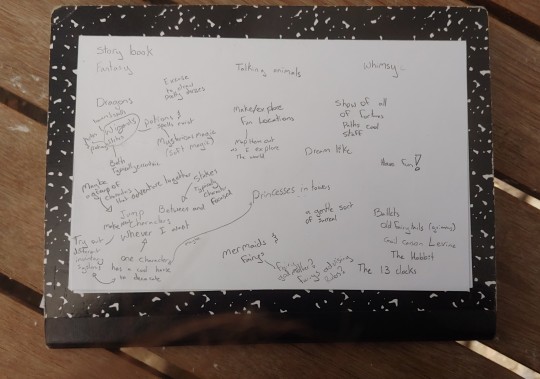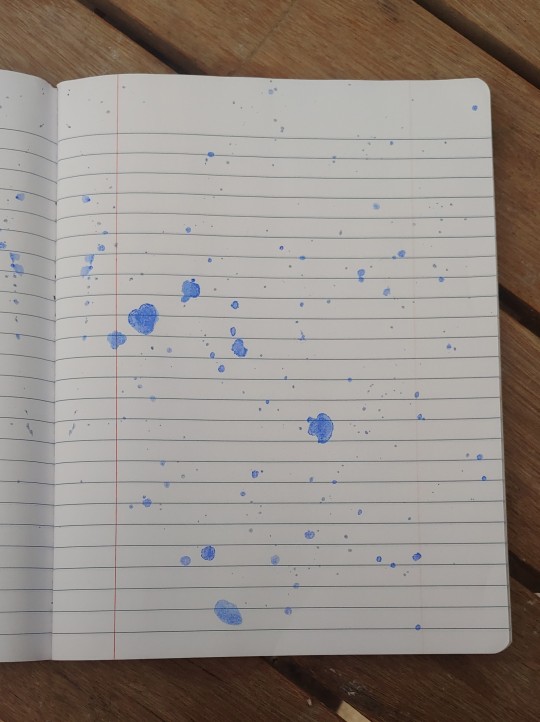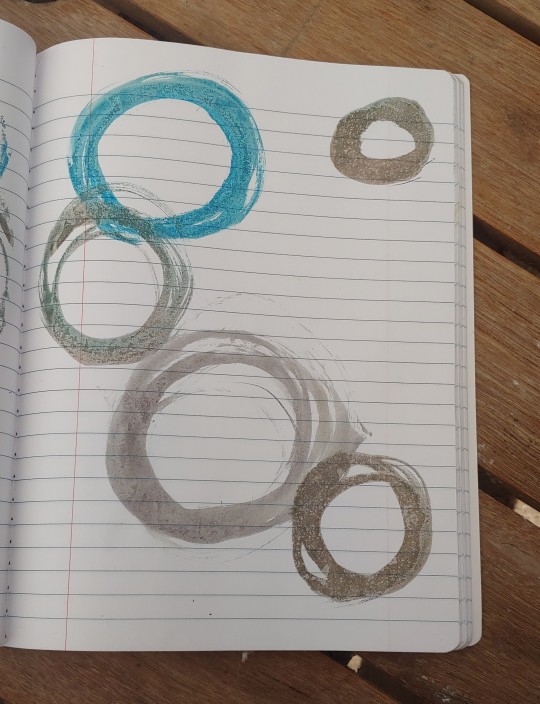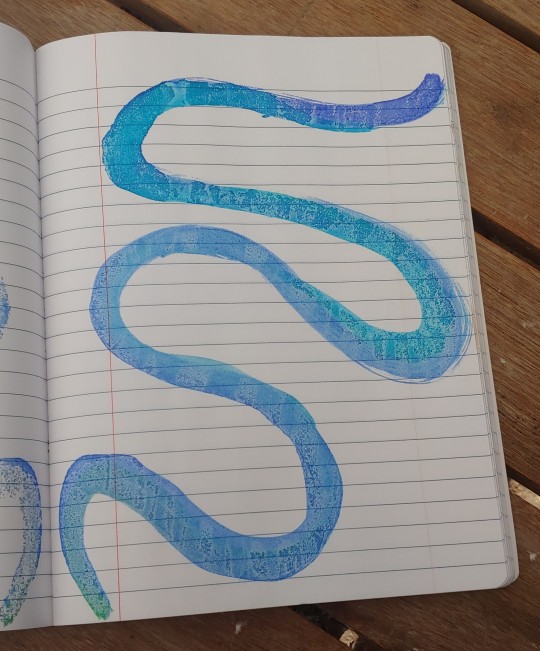#but i was probably working with a limited selection of yarn colors back then
Text

Yarn art for Dogust.
#dogust#border collie#border collies#fiber arts#yarn#it's on one of those plastic grid backings#like an oval place mat shape#artwoodelf#i think this dates back to my early teens but considering the materials i still think it's pretty decent#could maybe use a line of lighter color yarn to delineate the tail and the top of the folded hind leg#and maybe a bit more detail to the flowers#but i was probably working with a limited selection of yarn colors back then#i mean i did the border edge in orange#which would not have been my first choice if i had other colors on hand#but does provide a nice contrast i guess#i have no idea why i would ever have bought orange yarn in the first place unless it was for some halloween project#dogs#dog
14 notes
·
View notes
Text
Setting the Stage
Before you can play, you’ll need to figure out what sort of game you want to play in the first place! Get out something to write on and brainstorm things you want from this solo game. Having a good grasp of your goals from the get-go keeps things on track and prevents getting several hours in only to find you aren't having fun. Having the brainstorming sheet on hand to reference is great if you ever get stuck and don’t know what you want to do next.
What sort of world do you want to play in?
Genre and tone?
Fantasy
Magical girls
Horror
Cyberpunk
Scope of the story/world?
Town
Country
Planet
Galaxy
Universe
What stuff exists there?
Zombies
Talking animals
Androids
Magical weapons
Spaceships
Dragons
What media inspires this game?
Books
Movies
A dream you had
Tv shows
Video games
Board games
A beautiful painting you saw
Music
What sort of things do you want to do in this world?
Explore and map
Discover new potions
Bounty hunting
Help people
Collect cool treasure
Prank people
Save the world
Steal stuff

With all this in mind, next we need to select and prepare the stage for this game. I generally recommend a physical thing of some sort. Some fantastic options include:
That beautiful journal you’ve been holding on to, finally getting its chance to shine
A 3 ring binder for easy organizing
A coloring book
A journal cobbled together from junk
Random novel from the clearance section, thousands of prompts hidden in its pages
Box full of loose pages and trinkets
The canvas I’ve chosen for my game is the humble composition notebook; they’re easy to find, easy to store, and typically inexpensive. The final step of setting the stage is to add a handful of visual prompts to your canvas. Picking colors and techniques to suit your setting adds to the immersion to your game. For instance, for a sci-fi game about flying around in space ships I might use ball point pen, highlighter, charcoal/ graphite, geometric shapes, and black marker; whereas for a magical girl game I would probably use markers, glitter pens, stickers, and coloring pages.
In the interest of keeping this as accessible to everyone as possible I have chosen to limit my art supplies and keep a rough tally on how much I would have spent on supplies.
Total tally of supplies I used
Watercolor palette: 3.50$
Composition notebook: 99c
Handful of broken crayons: a new 8 pack is like a 1.50$
Pen, pencil and marker I found on the ground: free, about 4 bucks new
Regular printer paper: about 5$ for 500 sheets but I just yoink them from offices when I get the chance
8 Colored pencils I already had: about 4$ new
Shirt I don't wear anymore: free
A lone sock: free
Ball of cotton yarn: 3.50$
Index cards: 2.50$
Gluestick: 99c
Thread: 1.15$
Magazines, catalogs, and old books: free, check free libraries and ask your friends, save cool bits from junk mail
Visual prompts also provide inspiration mid game: a page of splatters might become a constellation, a cluster of fairies, the dust settling in the foreground after a battle, or just a beautiful background to write on. They also alleviate blank page anxiety by preemptively messing the pages up. I chose to add something about every 4th page, and I’m saving a bunch of extra collage materials in the back of my book for later.
Here are some ideas of stuff to add to get you started!
Scribbles
Blobs
Swirls
Paint splatters
Frames
Coloring pages
Envelopes
Pressed flowers
Magazine clippings
Book pages




Tomorrow we will talk about how Tarot works in Fortunes Path!
4 notes
·
View notes
Text
My Farm
I spend most of my time thinking about my farm. Right now I run a very small scale poultry breeding operation- I have two breeding groups of Orloffs and one group of turkeys- but I have much greater plans than that. I think about it constantly, because it is everything to me. So many plans I’ve had have become impossible due to finances, mental health, and disability. This, though, this is my goal and dream, the result of learning what I can and cannot do, what I do and do not enjoy doing. It will provide me the opportunity to learn hands-on, something I wanted to do via university but my health and finances won’t allow me to do.
I have many loose plans right now, but I haven’t written much of it down. I’m feeling blue at the moment, so I figured typing it out might help me.
My farm, currently named Equinox Giants farm (but my mom is arguing about registering our cattle under that name so it may change lmao,) will be a heritage livestock and poultry operation. We will specialize in dual purpose animals, predominantly in breeding in order to provide other people with stock.
Grain for the livestock will mostly come from spent brewery grains. These grains come from brewing various types of alcohol (especially beer!) Brewing companies cannot use these grains and must often pay for them to be hauled to a landfill. However they are nutrient-dense for ruminants. While not nutritionally complete on their own, when paired with good pasture (and/or hay), they make up a large portion of the diet and cut out the (very high) cost of livestock grain. Not all livestock can use them, but cattle, sheep, and poultry can. There are many breweries in New York, so finding one close will be easy enough. This also cuts down on waste in landfills!
All land in the USA is stolen land, and I cannot help that I was born and live here, but I can acknowledge that when I own my farm, that will be on land that once belonged to Indigenous peoples. So, where ever we end up, I plan to reach out to the tribe whose land we’re farming on and basically finding out what I can do about it. I don’t know what the options are, but I am sure there’s something.
Waste products will be collected and composted, the resulting fertilizer then will hopefully be sold to local greenhouses/gardeners (and used for my own tiny garden, I like to grow tomatoes!)
Now the animals themselves! Pasture land is the biggest factor currently on deciding where we move and establish the farm. We need enough to be able to rotate pasture, as that will seriously limit how much grain we have to feed and hay we have to buy (if we have the extra pasture for it then we’ll probably rent out the field to someone who hays in exchange for a portion of the hay.) All of the livestock breeds I’ll be breeding are heritage animals that are capable of thriving on very little. Dexter cattle and shetland sheep are excellent at using whatever forage is available. Rotating the Dexter herd and the Shetland (and Alpaca) flock on different pastures will allow the grass to continue growing through the growing season, providing the animals with food. Livestock guardian dogs will be kept with the herd and flock to help limit conflict with native predators (and keep stray/roaming dogs away, which can seriously destroy a herd.)
We will start small, and build slowly. One of the main reasons that new farms fail shortly after startup is starting too big and growing too fast, before the owner learns how to actually manage it.
The Dexter herd will ideally start as 2-3 bred heifers. Their offspring will be raised by the cows, and then once weaned the steers will be sold to feeders (where they go to mature more until butcher), and cow calves will likely be sold (unless any art particularly nice, which we’ll keep then to add to the herd.) We will acquire a polled dexter bull from a different source, so he can be used for breeding in the future. Temperament, health, and quality are of the upmost importance in all of my breeding programs. We’ll work with all three Dexter colors- red, black, and dun. This small herd will be grown slowly, over time as we adjust to rearing cattle and figure out what we can handle. I would like to milk the cows on a very small scale so that I can make my own cheeses and butter. The bull will be named Papa Moofasa.
The Shetland sheep herd will also start off small. Shetlands themselves are teeny tiny, so you can keep a large number in small pastures. I’d like to start with 3-5 ewes and one ram. Specifically selecting for a medium crimp and length in fiber. I’ll be part of the Shave ‘Em to Save ‘Em program, which works to connect fiber produces directly to fiber artists. I would like to get decent equipment to card and spin the wool and fiber myself so that I can sell yarn. I may also keep some Friesian sheep as dairy animals to make my own sheep cheeses.
Due to the different texture and quality of Alpaca fiber to sheep fiber, I’d also like to keep a small herd of Huacaya Alpacas. Mostly because when I’ve worked with Alpacas in the past I really enjoyed their company and noises. Pleasant little fellows. I need to do a lot more research into them, though.
Chickens are one of my biggest joys, and will likely be my largest flock as far as quantity of individuals goes. I specialize in Russian Orloffs, but will also keep and breed Wyandottes, Chanteclers, Modern Game, and Sanjak Longcrowers. I will sell eggs for hatching, chicks, grow-outs, and mature breeding birds to people interested in showing, breeding, or simply having pets. I will also process to sell whole carcasses, and will sell eggs for eating as well.
Turkey varieties will be black and chocolate, and I will sell poults, grow-outs, and meat. I’m greedy and turkeys are seasonal layers so eggs I’ll keep for myself for hatching. (May sell some for eating on rare occasion.)
As far as selling goods, it’ll be done mostly via direct to buyers. During warm months I’ll sell at local farmer’s markets. Eggs, chicks, and grow-outs will be sold to anyone in the lower 48 USA via shipping. Mature birds (and grow outs) will be sold at poultry shows. The big goal for the goods is to find the right markets. Specializing in humanely raised, heritage livestock and poultry already gets me into a nice niche with that. Advertising small-farm, pasture-raised, heritage livestock and poultry looks good (as it should! It’s more sustainable!) and helps with marketing, haha.
As with most start-up businesses, especially farms, it’ll be a while before we’re breaking even, and longer still until we’re turning a profit. This is something I recognize going into it. I ain’t in it to make money, if I wanted to make money I would not get into livestock, haha, but to preserve these breeds, provide people with a source of ethically raised products and well-bred animals, and hopefully give back to the community in meaningful ways.
Anyways, just felt like rambling for a little bit to help my frazzled brain relax. Happy New Year, y’all.
38 notes
·
View notes